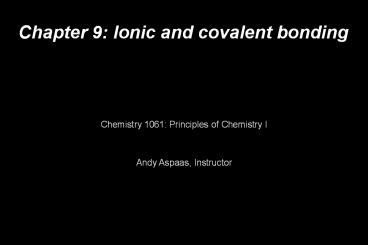Chapter 9: Ionic and covalent bonding - PowerPoint PPT Presentation
Title:
Chapter 9: Ionic and covalent bonding
Description:
Fluorine is the most electronegative element, Cesium is the least ... (atom arrangement) by choosing a central atom (usually least electronegative) ... – PowerPoint PPT presentation
Number of Views:194
Avg rating:3.0/5.0
Title: Chapter 9: Ionic and covalent bonding
1
Chapter 9 Ionic and covalent bonding
Chemistry 1061 Principles of Chemistry I Andy
Aspaas, Instructor
2
Electron configuration of ions
- Ionic bonds formed by electrostatic attraction
between oppositely-charged ions - Ions are normally formed by adding or removing
electrons from atoms to give them a noble-gas
configuration - Consider formation of sodium chloride
- Na (Ne3s1) Cl (Ne3s23p5) ? Na (Ne)
Cl (Ne3s23p6) - The oppositely charged sodium cation and chloride
anion now have noble-gas configurations, and
become ionically bonded - NaCl crystal involves an orderly arrangement of
Na and Cl ions
3
Signifying ionic bond formation
- Lewis electron-dot symbols valence electrons
(electrons in outer shell) represented by dots
drawn around atoms element symbol - First put one dot on each of 4 sides, then add
2nd dot to each side, until all valence electrons
are drawn - Na Cl ? Na Cl
4
Energy involved in ionic bonding
- Ionization energy energy required for an atom to
lose an electron - Positive value, but small for groups IA - IIIA
- Electron affinity energy released when an atom
gains an electron - Negative value, especially favorable for groups
VIA - VII7A - Ion pair energy energy released when oppositely
charged ions are brought into a pair (calculated
by Coulombs law) - Lattice energy energy required to break a
lattice of ions into gas-phase atoms (reverse is
the energy released when forming gas-phase ions
into a lattice)
5
Properties of ionic substances
- Ionic substances normally high-melting solids
- Due to strong attractions between ions which must
be broken if the solid is to melt - MgO has much higher melting point than NaCl,
since each ion has 2/2 charge instead of just
1/1 - Molten ionic substances conduct electricity, just
like a solution with dissolved ions would
6
Predicting ion charges
- Groups IA IIA form cations to give noble-gas
configurations (charge group ) - Metals in groups IIIA - VA can form cations
either with noble-gas configuration, or with ns2
configurations (charge group or group 2) - Nonmetals in groups VA - VIIA form anions with
noble-gas configurations (charge 8 group ) - Many transition metals form 2 charges by losing
their two highest s electrons - 3 is formed by losing the two highest s
electrons and one d electron
7
Covalent bonds
- Covalent bonds involve sharing of a pair
electrons between two atoms - Ex. Formation of H2 H H ? H H
- Electron pairs in Lewis electron-dot formula can
be either bonding pair (shared between two atoms)
or a nonbonding pair (unshared, remains on one
atom) - Covalent bonds usually exist between nonmetals,
where formation of an ion-pair would be
unfavorable - Octet rule many atoms prefer 8 valence electrons
available when forming covalent bonds (some do
not)
8
Polar covalent bonds
- Electronegativity ability of an atom in a
molecule to draw bonding electrons to itself - Fluorine is the most electronegative element,
Cesium is the least - Electronegativity decreases as you go left, or
down on the periodic table - Uneven electronegativities of atoms involved in a
covalent bond will yield uneven sharing of the
electrons this is a polar bond
9
Lewis structures
- Lewis structure electron dot structure for an
entire molecule - Use dots to indicate unshared electrons and lines
to indicate covalent bonds - One line represents a single bond (2 shared
electrons) - 2 lines for a double bond, 3 for a triple bond,
etc
10
Drawing Lewis structures
- Predict skeleton structure (atom arrangement) by
choosing a central atom (usually least
electronegative) - Find the total number of valence electrons in the
molecule (for a polyatomic ion, add an electron
for a 1 charge, remove an electron for a 1
charge) - Count the bonds you have already drawn as pairs
of valence electrons, and distribute remaining
valence electrons as pairs among the surrounding
atoms to satisfy octet rules - Add remaining electrons as pairs to central atom
- If octets cannot be filled, try adding double or
triple bonds (C, N, O, and S often form multiple
bonds)
11
Exceptions to the octet rule
- Nonmetals in row 3 and beyond can use
higher-energy empty d orbitals for bonding - Ex. PF5 and SF6
- Also group IIA and IIIA atoms can form covalent
compounds with less than 8 electrons in their
valence shells - Ex. BF3, BeF2
12
Formal charges
- Hypothetical charges on individual atoms in a
molecule - Formal charge valence electrons on free atom
- 1/2 shared electrons
- unshared (lone-pair) electrons
- If several Lewis structures are possible, the
most important Lewis structure is the one with
the fewest formal charges - If two Lewis structures have the same number (and
magnitude) of formal charges, choose the one with
the negative formal charge on the more
electronegative atom































